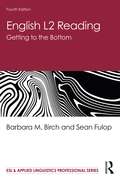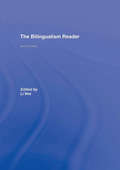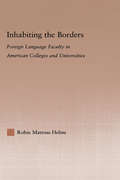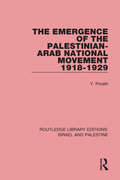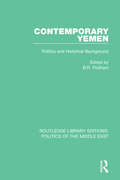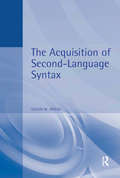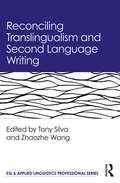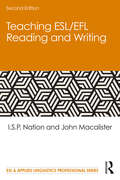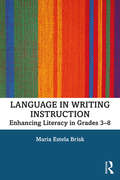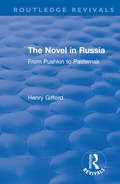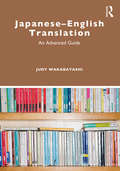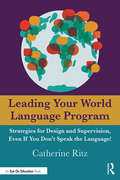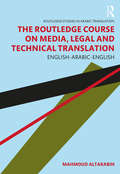- Table View
- List View
English L2 Reading: Getting to the Bottom (ESL & Applied Linguistics Professional Series)
by Barbara M. Birch Sean FulopEnglish L2 Reading: Getting to the Bottom uses research-based insights to examine bottom-up skills in reading English as a second language. This fourth edition clearly presents core concepts alongside their practical applications to teaching contexts, with updated research findings, a new focus on metalinguistic awareness, and new resources for students. The text’s pedagogical features help readers connect linguistic details and psycholinguistic theory with practical explanations and teaching suggestions. Pre-reading Questions challenge readers to analyze their own experiences. Study Guide Questions allow readers to review, discuss, and assess their knowledge. Discussion Questions elaborate on themes in each chapter, while the new Language Awareness Activities help develop metalinguistic awareness. Three Appendices provide tables that list the graphemes and the phonemes of English, as well as a brand-new dictionary pronunciation guide. New to the fourth edition: Substantially revised and updated research on linguistics New, evidence-based models on the reading process Language Awareness Activities that highlight metalinguistic awareness Word study examples in each chapter For teachers, teacher trainers, reading researchers, or anyone interested in teaching reading, this popular, comprehensive, myth-debunking text provides clear and practical guidance towards effectively supplementing top-down teaching approaches with bottom-up reading strategies.
The Bilingualism Reader
by Li WeiThe Bilingualism Reader is the definitive reader for the study of bilingualism. Designed as an integrated and structured student resource it provides invaluable editorial material that guides the reader through different sections and covers:definitions and typology of bilingualism language choice and bilingual interaction bilingualism, identity and ideology grammar of code-switching and bilingual acquisition bilingual production and perception the bilingual brain methodological issues in the study of bilingualism. The second edition of this best selling volume includes nine new chapters and postscripts written by the authors of the original articles, who evaluate them in the light of recent research. Critical discussion of research methods, revised graded study questions and activities, a comprehensive glossary, and an up-to-date resource list make The Bilingualism Reader an essential introductory text for students of linguistics, psychology and education.
Inhabiting the Borders: Foreign Language Faculty in American Colleges and Universities (Studies in Higher Education)
by Robin Matross HelmsThis book focuses on the experience of foreign language faculty in American colleges and universities, the challenges they face, and ways that academia can better support language faculty, and marginalized faculty in other fields, in their important work.
The Emergence of the Palestinian-Arab National Movement, 1918-1929 (RLE Israel and Palestine)
by Yehoshua PorathThe resurgence of Palestinian nationalism in the wake of the 1967 Arab-Israeli war tended to overshadow the fact that Palestinian national consciousness is not a new phenomenon, but traces its origins back to the time when the first stirrings of nationalism were being felt in many parts of the under-developed world. This work, first published in 1974, is based on both Arabic and Hebrew primary sources as well as English and French official and unofficial documents, and was the first detailed study of the infancy period of Palestinian nationalism. The book begins by establishing the position of Palestine and Jerusalem in Islamic history and their significance within the concepts of Islam, and outlines the social and political features of the Palestinian population at the beginning of the First World War. The author then charts in detail the development of Palestinian nationalism over the decade after the War. Two major forces influenced this development and reacted with it: Zionism, with its ambitious schemes for settling Jews in Palestine and creating a National Home for them there, and Arab nationalism on a wider scale, which was emerging spontaneously with the disintegration of the Ottoman Empire and the spreading of ideas of self-determination. The growing threat posed by Zionism awoke the Palestinian population to the need for organization and the establishment of their own identity to oppose it, while the focus of their national aspirations widened or narrowed according to the ability which they felt at any given time to confront Zionism and achieve self-expression within a Palestinian rather than an all-Syrian national framework. The events of these turbulent years – the confrontations with the British, delegations, boycotts, proposals and rejections, the emergence of al-Hajj Amin al-Husayni, the Wailing Wall conflict and its repercussions – are all described within the context of these wider considerations, which also include Britain’s own role as holder of the Mandate over Palestine.
Contemporary Yemen: Politics and Historical Background
by B. R. PridhamThis book presents some papers presented to a symposium on contemporary Yemen held in July 1983 by Exeter University's Centre for Arab Gulf Studies in collaboration with the Universities of Aden and San'a', and deals with history, internal and international politics, and administrative subjects.
Acquisition of Second Language Syntax
by Susan BraidiThis book deals with the questions asked about the L2 acquisition process within different research paradigms, examines the results found in each approach, and evaluates the contributions of each to our understanding of L2 acquisition of syntax and to possible implications for L2 instruction.
The Bilingualism Reader
by Li WeiThe Bilingualism Reader is the definitive reader for the study of bilingualism. Designed as an integrated and structured student resource it provides invaluable editorial material that guides the reader through different sections and covers:definitions and typology of bilingualism language choice and bilingual interaction bilingualism, identity and ideology grammar of code-switching and bilingual acquisition bilingual production and perception the bilingual brain methodological issues in the study of bilingualism. The second edition of this best selling volume includes nine new chapters and postscripts written by the authors of the original articles, who evaluate them in the light of recent research. Critical discussion of research methods, revised graded study questions and activities, a comprehensive glossary, and an up-to-date resource list make The Bilingualism Reader an essential introductory text for students of linguistics, psychology and education.
Inhabiting the Borders: Foreign Language Faculty in American Colleges and Universities (Studies in Higher Education)
by Robin Matross HelmsThis book focuses on the experience of foreign language faculty in American colleges and universities, the challenges they face, and ways that academia can better support language faculty, and marginalized faculty in other fields, in their important work.
The Emergence of the Palestinian-Arab National Movement, 1918-1929 (RLE Israel and Palestine)
by Yehoshua PorathThe resurgence of Palestinian nationalism in the wake of the 1967 Arab-Israeli war tended to overshadow the fact that Palestinian national consciousness is not a new phenomenon, but traces its origins back to the time when the first stirrings of nationalism were being felt in many parts of the under-developed world. This work, first published in 1974, is based on both Arabic and Hebrew primary sources as well as English and French official and unofficial documents, and was the first detailed study of the infancy period of Palestinian nationalism. The book begins by establishing the position of Palestine and Jerusalem in Islamic history and their significance within the concepts of Islam, and outlines the social and political features of the Palestinian population at the beginning of the First World War. The author then charts in detail the development of Palestinian nationalism over the decade after the War. Two major forces influenced this development and reacted with it: Zionism, with its ambitious schemes for settling Jews in Palestine and creating a National Home for them there, and Arab nationalism on a wider scale, which was emerging spontaneously with the disintegration of the Ottoman Empire and the spreading of ideas of self-determination. The growing threat posed by Zionism awoke the Palestinian population to the need for organization and the establishment of their own identity to oppose it, while the focus of their national aspirations widened or narrowed according to the ability which they felt at any given time to confront Zionism and achieve self-expression within a Palestinian rather than an all-Syrian national framework. The events of these turbulent years – the confrontations with the British, delegations, boycotts, proposals and rejections, the emergence of al-Hajj Amin al-Husayni, the Wailing Wall conflict and its repercussions – are all described within the context of these wider considerations, which also include Britain’s own role as holder of the Mandate over Palestine.
Contemporary Yemen: Politics and Historical Background
by B. R. PridhamThis book presents some papers presented to a symposium on contemporary Yemen held in July 1983 by Exeter University's Centre for Arab Gulf Studies in collaboration with the Universities of Aden and San'a', and deals with history, internal and international politics, and administrative subjects.
Acquisition of Second Language Syntax
by Susan BraidiThis book deals with the questions asked about the L2 acquisition process within different research paradigms, examines the results found in each approach, and evaluates the contributions of each to our understanding of L2 acquisition of syntax and to possible implications for L2 instruction.
Reconciling Translingualism and Second Language Writing (ESL & Applied Linguistics Professional Series)
by Tony Silva Zhaozhe WangThis book brings together top scholars on different sides of the important scholarly debate between the translingual movement and the field of second language writing. Drawing on a wide range of perspectives, this volume examines the differences in theory and practice with the hope of promoting reconciliation between the two schools of thought. Chapters address the tensions in the relationship between translingualism and second language writing and explore programs, pedagogies, and research that highlight commonalities between the two camps. With contributions from leading scholars, this book comprehensively addresses the issues related to this contentious debate and offers ways to bring the two camps into conversation with one another in a way that promotes effective teaching practices. By providing a panoramic view of the current situation, the text is a timely and unique contribution to TESOL, applied linguistics, and composition studies.
Reconciling Translingualism and Second Language Writing (ESL & Applied Linguistics Professional Series)
by Tony Silva; Zhaozhe WangThis book brings together top scholars on different sides of the important scholarly debate between the translingual movement and the field of second language writing. Drawing on a wide range of perspectives, this volume examines the differences in theory and practice with the hope of promoting reconciliation between the two schools of thought. Chapters address the tensions in the relationship between translingualism and second language writing and explore programs, pedagogies, and research that highlight commonalities between the two camps. With contributions from leading scholars, this book comprehensively addresses the issues related to this contentious debate and offers ways to bring the two camps into conversation with one another in a way that promotes effective teaching practices. By providing a panoramic view of the current situation, the text is a timely and unique contribution to TESOL, applied linguistics, and composition studies.
Teaching ESL/EFL Reading and Writing (ESL & Applied Linguistics Professional Series)
by I.S.P. Nation John MacalisterThe second edition of this bestselling text, Teaching ESL/EFL Reading and Writing, is a fully updated and expanded guide for teaching learners at all levels of proficiency how to develop their reading and writing skills and fluency. Practical and accessible, this book covers a diverse array of language teaching techniques suitable for all contexts. Updated with cutting-edge research and theory, the second edition is an essential and engaging text. Key insights and suggestions are organised around four strands – meaning-focused input, meaning-focused output, language-focused learning, and fluency development – to allow teachers to design and present a balanced programme for their students. Bringing together research and theory in applied linguistics and education, the text includes useful examples and practical strategies and features new topics related to technology, assessment, and genre. The second edition includes new tasks and further reading sections in every chapter. Teaching ESL/EFL Reading and Writing is designed for practising and pre-service teachers of all levels, and is ideal for certificate, diploma, masters, and doctoral courses in English as a second or foreign language.
Teaching ESL/EFL Reading and Writing (ESL & Applied Linguistics Professional Series)
by I.S.P. Nation John MacalisterThe second edition of this bestselling text, Teaching ESL/EFL Reading and Writing, is a fully updated and expanded guide for teaching learners at all levels of proficiency how to develop their reading and writing skills and fluency. Practical and accessible, this book covers a diverse array of language teaching techniques suitable for all contexts. Updated with cutting-edge research and theory, the second edition is an essential and engaging text. Key insights and suggestions are organised around four strands – meaning-focused input, meaning-focused output, language-focused learning, and fluency development – to allow teachers to design and present a balanced programme for their students. Bringing together research and theory in applied linguistics and education, the text includes useful examples and practical strategies and features new topics related to technology, assessment, and genre. The second edition includes new tasks and further reading sections in every chapter. Teaching ESL/EFL Reading and Writing is designed for practising and pre-service teachers of all levels, and is ideal for certificate, diploma, masters, and doctoral courses in English as a second or foreign language.
Language in Writing Instruction: Enhancing Literacy in Grades 3-8
by María Estela BriskAccessible and engaging, this book offers a comfortable entry point to integrating language instruction in writing units in grades 3–8. A full understanding of language development is necessary for teaching writing in a successful and meaningful way. Applying a Systemic Functional Linguistics (SFL) approach, María Brisk embraces an educator’s perspective, breaks down the challenges of teaching language for non-linguists, and demonstrates how teachers can help students express their ideas and create cohesive texts. With a focus on the needs of all students, including bilingual and English language learners, Brisk addresses topics necessary for successful language instruction, and moves beyond vocabulary and grammar to address meaning-making and genre. This book provides a wealth of tools and examples for practice and includes helpful instructional resources that teachers can return to time after time. Moving from theory to practice, this teacher-friendly text is a vital resource for courses in language education programs, in-service teacher-training seminars, and for pre-service and practicing English Language Arts (ELA) teachers who want to expand their teaching abilities and knowledge bases. This book features a sample unit and a reference list of instructional resources.
Language in Writing Instruction: Enhancing Literacy in Grades 3-8
by María Estela BriskAccessible and engaging, this book offers a comfortable entry point to integrating language instruction in writing units in grades 3–8. A full understanding of language development is necessary for teaching writing in a successful and meaningful way. Applying a Systemic Functional Linguistics (SFL) approach, María Brisk embraces an educator’s perspective, breaks down the challenges of teaching language for non-linguists, and demonstrates how teachers can help students express their ideas and create cohesive texts. With a focus on the needs of all students, including bilingual and English language learners, Brisk addresses topics necessary for successful language instruction, and moves beyond vocabulary and grammar to address meaning-making and genre. This book provides a wealth of tools and examples for practice and includes helpful instructional resources that teachers can return to time after time. Moving from theory to practice, this teacher-friendly text is a vital resource for courses in language education programs, in-service teacher-training seminars, and for pre-service and practicing English Language Arts (ELA) teachers who want to expand their teaching abilities and knowledge bases. This book features a sample unit and a reference list of instructional resources.
The Novel in Russia: From Pushkin to Pasternak
by Henry GiffordThe Novel in Russia examines the Russian sensibility as it is revealed in prose fiction, the dominant mode of Russian literature. It explores how, in the work of Pushkin, Lermontov and Gogol, narrative art forsakes poetry for prose, and considers in turn six authors from the great age of prose realism: Goncharov, Turgenev, Leskov, Tolstoy, Saltykov-Shchedrin and Dostoevsky. The book provides an account of Chekhov and Gorky, appraises 'decadent' prose, the earlier Soviet writing, the school of Socialist Realism, and Doctor Zhivago. The theme of the writer's contest with critical pressure and State interference runs throughout.
The Novel in Russia: From Pushkin to Pasternak
by Henry GiffordThe Novel in Russia examines the Russian sensibility as it is revealed in prose fiction, the dominant mode of Russian literature. It explores how, in the work of Pushkin, Lermontov and Gogol, narrative art forsakes poetry for prose, and considers in turn six authors from the great age of prose realism: Goncharov, Turgenev, Leskov, Tolstoy, Saltykov-Shchedrin and Dostoevsky. The book provides an account of Chekhov and Gorky, appraises 'decadent' prose, the earlier Soviet writing, the school of Socialist Realism, and Doctor Zhivago. The theme of the writer's contest with critical pressure and State interference runs throughout.
Japanese–English Translation: An Advanced Guide
by Judy WakabayashiThis volume is a textbook for aspiring translators of Japanese into English, as well as a reference work for professional Japanese–English translators and for translator educators. Underpinned by sound theoretical principles, it provides a solid foundation in the practice of Japanese–English translation, then extends this to more advanced levels. Features include: 13 thematic chapters, with subsections that explore common pitfalls and challenges facing Japanese–English translators and the pros and cons of different procedures exercises after many of these subsections abundant examples drawn from a variety of text types and genres and translated by many different translators This is an essential resource for postgraduate students of Japanese–English translation and Japanese language, professional Japanese–English translators and translator educators. It will also be of use and interest to advanced undergraduates studying Japanese.
Japanese–English Translation: An Advanced Guide
by Judy WakabayashiThis volume is a textbook for aspiring translators of Japanese into English, as well as a reference work for professional Japanese–English translators and for translator educators. Underpinned by sound theoretical principles, it provides a solid foundation in the practice of Japanese–English translation, then extends this to more advanced levels. Features include: 13 thematic chapters, with subsections that explore common pitfalls and challenges facing Japanese–English translators and the pros and cons of different procedures exercises after many of these subsections abundant examples drawn from a variety of text types and genres and translated by many different translators This is an essential resource for postgraduate students of Japanese–English translation and Japanese language, professional Japanese–English translators and translator educators. It will also be of use and interest to advanced undergraduates studying Japanese.
Leading Your World Language Program: Strategies for Design and Supervision, Even If You Don’t Speak the Language!
by Catherine RitzAn essential resource for district, school, and program leaders who supervise, evaluate, or otherwise support World Language programs, this book provides clear, practical guidance on leading an exemplary K–12 World Language program. No matter whether you speak the language, the effective approaches in this book will equip you with the tools you need to implement and evaluate World Language curricula in your school. Catherine Ritz provides a clear and research-based framework for World Language instruction aligned to rigorous national and state standards, and addresses essential concepts and topics, including program and curriculum design, assessment and evaluation, and strategic planning. Whether you are a World Language department chair with years of experience, a school administrator with no background in language education, or a World Language teacher, you will find much to use in this book. It is chock-full of ready-to-use resources and tools, including: Templates for program and unit planning, observation protocols, and sample assessments World LAnguage program models for different age ranges, and a sample curriculum unit Additional resource lists and further reading recommendations.
Leading Your World Language Program: Strategies for Design and Supervision, Even If You Don’t Speak the Language!
by Catherine RitzAn essential resource for district, school, and program leaders who supervise, evaluate, or otherwise support World Language programs, this book provides clear, practical guidance on leading an exemplary K–12 World Language program. No matter whether you speak the language, the effective approaches in this book will equip you with the tools you need to implement and evaluate World Language curricula in your school. Catherine Ritz provides a clear and research-based framework for World Language instruction aligned to rigorous national and state standards, and addresses essential concepts and topics, including program and curriculum design, assessment and evaluation, and strategic planning. Whether you are a World Language department chair with years of experience, a school administrator with no background in language education, or a World Language teacher, you will find much to use in this book. It is chock-full of ready-to-use resources and tools, including: Templates for program and unit planning, observation protocols, and sample assessments World LAnguage program models for different age ranges, and a sample curriculum unit Additional resource lists and further reading recommendations.
The Routledge Course on Media, Legal and Technical Translation: English-Arabic-English (Routledge Studies in Arabic Translation)
by Mahmoud AltarabinThe Routledge Course on Media, Legal and Technical Translation: English-Arabic-English is an indispensable and engaging coursebook for university students wishing to develop their English-Arabic-English translation skills in these three text types. Taking a practical approach, the book introduces Arab translation students to common translation strategies in addition to the linguistic, syntactic, and stylistic features of media, legal, and technical texts. This book features texts carefully selected for their technical relevance. The key features include: • comprehensive four chapters covering media, legal, and technical texts, which are of immense importance to Arab translation students; • detailed and clear explanations of the lexical, syntactic, and stylistic features of English and Arabic media, legal, and technical texts; • up-to-date and practical translation examples in both directions offering students actual experiences of professional translators; • authentic texts extracted from various sources to promote students’ familiarity with language features and use; • extensive range of exercises following each section of the book to enable students to test and practice the knowledge and skills they developed from reading previous sections; • glossaries following most exercises containing the translation of difficult words; and • a list of recommended readings following each chapter. The easy, practical, and comprehensive approach adopted in the book makes it a must-have coursebook for intermediate and advanced students studying translation between English and Arabic. University instructors and professional translators working on translation between English and Arabic will find this book particularly useful.
The Routledge Course on Media, Legal and Technical Translation: English-Arabic-English (Routledge Studies in Arabic Translation)
by Mahmoud AltarabinThe Routledge Course on Media, Legal and Technical Translation: English-Arabic-English is an indispensable and engaging coursebook for university students wishing to develop their English-Arabic-English translation skills in these three text types. Taking a practical approach, the book introduces Arab translation students to common translation strategies in addition to the linguistic, syntactic, and stylistic features of media, legal, and technical texts. This book features texts carefully selected for their technical relevance. The key features include: • comprehensive four chapters covering media, legal, and technical texts, which are of immense importance to Arab translation students; • detailed and clear explanations of the lexical, syntactic, and stylistic features of English and Arabic media, legal, and technical texts; • up-to-date and practical translation examples in both directions offering students actual experiences of professional translators; • authentic texts extracted from various sources to promote students’ familiarity with language features and use; • extensive range of exercises following each section of the book to enable students to test and practice the knowledge and skills they developed from reading previous sections; • glossaries following most exercises containing the translation of difficult words; and • a list of recommended readings following each chapter. The easy, practical, and comprehensive approach adopted in the book makes it a must-have coursebook for intermediate and advanced students studying translation between English and Arabic. University instructors and professional translators working on translation between English and Arabic will find this book particularly useful.
